
views
X
Research source
Setting up the Perfect Habitat
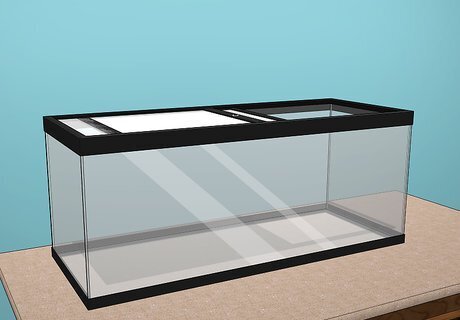
Give your beetle a home that’s 5 times taller and wider than its length. Choose a glass or plastic tank. You can keep about 3-5 beetles in a habitat that size. Give the beetles plenty of room to wander around. Remember that a bigger space is always better. You can buy a glass terrarium or plastic critter keeper from a pet store, but a plastic storage bin also works. Beetles can’t climb glass or plastic walls, so you don’t need a lid for the habitat. If you prefer to have a lid, be sure it’s ventilated so air can flow in and out of the cage.

Add 2 inches (5.1 cm) of substrate to the bottom of their habitat. Because blue death feigning beetles are desert beetles, they prefer a sand based substrate. Play sand alone works fine, but many people like to mix in coconut fiber, or dead leaves into the sand. Do not use a dirt-based substrate. It can accumulate on the beetles' feet and become hazardous to their health.
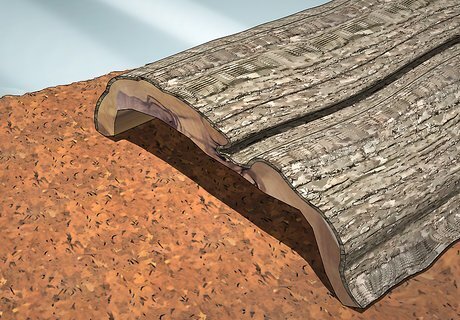
Provide hiding places. Add some branches and twigs to the habitat. You can provide your beetles with a hiding spot by simply leaning a piece of bark against the side of the cage. You can also buy a wooden half log from a pet store to use as a hiding spot. A toilet paper roll that is half buried in the substrate works too. Blue death feigning beetles are diurnal, meaning that they are active during the day and sleep at night. They like to be safely hidden away at night. Remember that the more beetles you have, the more hiding spots you will have to provide.

Add a food dish. One small ceramic or plastic food dish should be able to hold enough food for many beetles. If you have a larger colony of beetles, you might want to consider adding multiple food dishes. It is important to keep the food you feed your beetles off of the substrate to prevent mold growth. You can buy a food dish from a pet store or use a small overturned lid as a food dish.
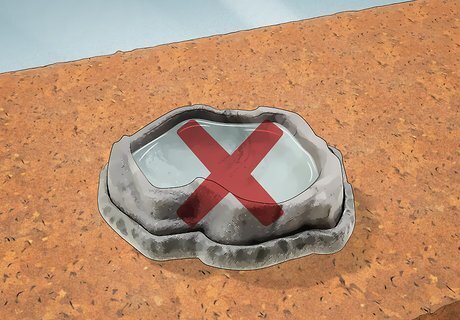
Skip the water dish. Blue death feigning beetles get all the water they need from the food they eat. Beetles are also not strong swimmers, so if they accidentally fall in a small dish of water, they may drown. Blue death feigning beetles come from a desert environment, so they are quite used to not having access to large amounts of drinking water.
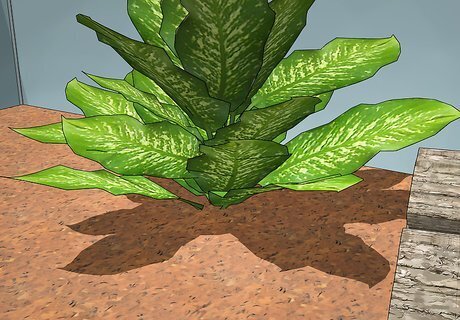
Add decorations, if desired. You don’t need to add any extra decorations to your beetles’ habitat, but they can add aesthetic appeal. Plant live plants in the substrate or buy some terrarium decorations at your local pet store. If you use live plants, there is a good chance that your beetles will slowly eat them. If you’d rather keep plants as decoration and not beetle food, try adding fake plants instead. Be careful to not make the habitat too crowded with decorations. Make sure your beetles still have space to walk around freely.
Maintaining Optimal Conditions for the Beetles
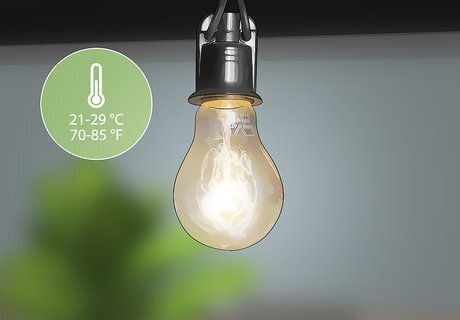
Keep the habitat between 70–85 °F (21–29 °C). If your house does not stay this warm, use an incandescent light bulb. Hang it over the top of the habitat to simulate the sun. Beetles can bask in the heat of the bulb if they want, or hide under the branches and leaves you provide to stay cool. If you have an extra-large habitat, you can also find heat mats at your local pet store that can be put under the tank to help keep the beetles comfortable.
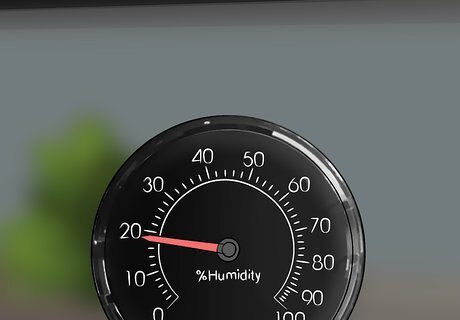
Ensure the humidity stays below 20%. Blue death feigning beetles are desert creatures, so the humidity should be kept low. Simply lightly mist the habitat with water once per week to keep it from drying out completely. The color of the beetles is based on the relative humidity. Beetles living in a habitat with higher humidity will turn a blackish color, while beetles that are kept in low humidity, are bright blue. Lower humidity means more colorful beetles. If you live in an area of high humidity, you may want to invest in a hygrometer to measure the level of humidity in the terrarium. If you notice it is getting too high, mist the habitat once every other week. You can also increase the ventilation in the habitat by removing the lid of the habitat, if you have one.
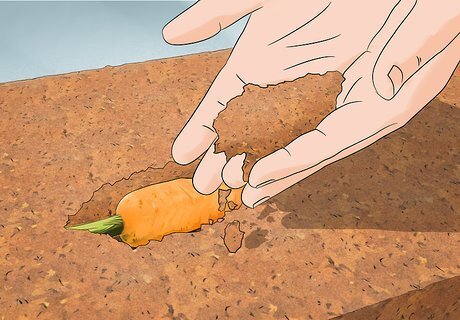
Bury carrots in the habitat to encourage breeding. These beetles are notoriously difficult to breed successfully. However, burying a few carrots in the habitat and keeping the substrate around them moist can help get your beetles to breed and provide a food source for the larvae when they hatch.
Feeding
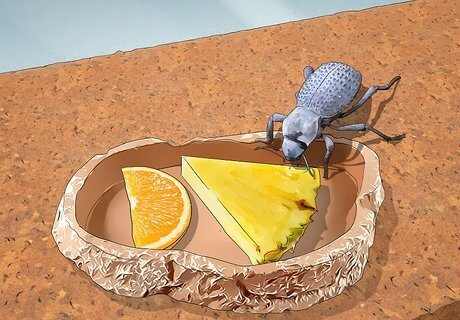
Make sure the beetles always have fresh fruit. Place a few small pieces of fruit on their food dish. Try banana, apple, orange, grape, pineapple, or mango. Remove the fruit after 2 days and supply new pieces. Try to give one type of fruit at a time until you find out what they like. Notice if there are any fruits they eat faster than others. Once you figure out their favorites, rotate between them. If you have a lot of beetles, and they are eating all the fruit you give them within 2 days, give them a couple of extra pieces. After some time, you’ll have a good idea of how much fruit they can eat within 48 hours.
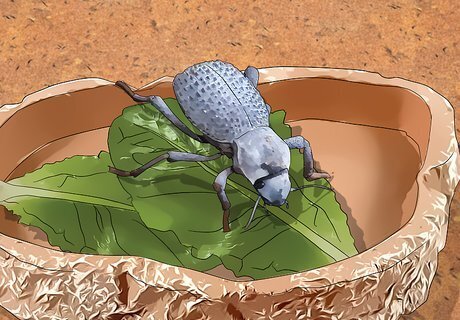
Give the beetles fresh vegetables. Blue death feigning beetles are omnivorous, which means they will eat nearly anything you give them. They often enjoy chopped carrots, celery, and lettuce. Give them 1 or 2 small pieces (about the size of your fingernail) at a time. Remove any uneaten pieces after 2 days. If you have more than 5 beetles, give them 3-4 pieces at a time. While fruits will provide vital nutrients and water, it’s nice to vary the food you give the beetles so they don’t get bored.
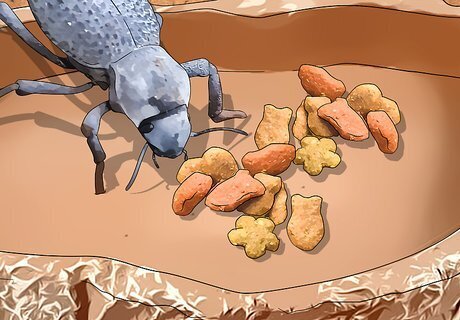
Add variety to the beetles’ diet with vegetables and grains and other treats. Add small amounts of moistened dog and cat kibble or grains to their food dish. Take away any uneaten bits after 24 hours. Try adding these extra treats a couple times per week.
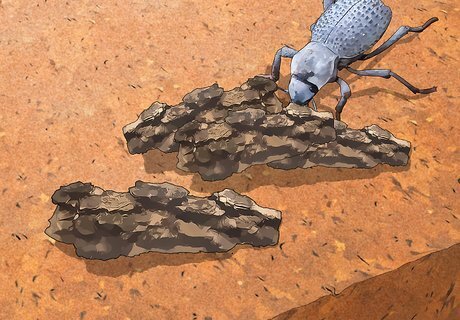
Put tree bark in the habitat to let the beetles eat like their wild counterparts. Find trees with lichens growing on the bark. Strip off some small pieces of the bark with a sharp knife. Put the bark in the beetle habitat. Replace it with fresh bark every month. If you have several beetles, be sure to break the bark into a few pieces and scatter them around their habitat so everyone can have a chance at finding some. To keep the lichen fresh and tasty, mist it with some water 3 times per week.
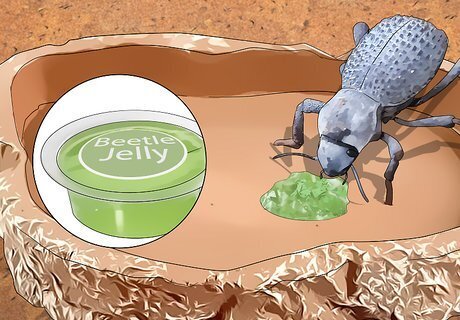
Buy commercial beetle food for a mess-free solution. Find special beetle food at your local pet store or online. It usually comes in little plastic cups. Check the label to find out the right daily amount to feed your beetles. Even if you choose to fulfill your beetles’ nutritional requirements with commercial beetle food, you should still give fruits, vegetables, bark, and other treats to the beetles once or twice per week to give them some variety in their diet.


















Comments
0 comment